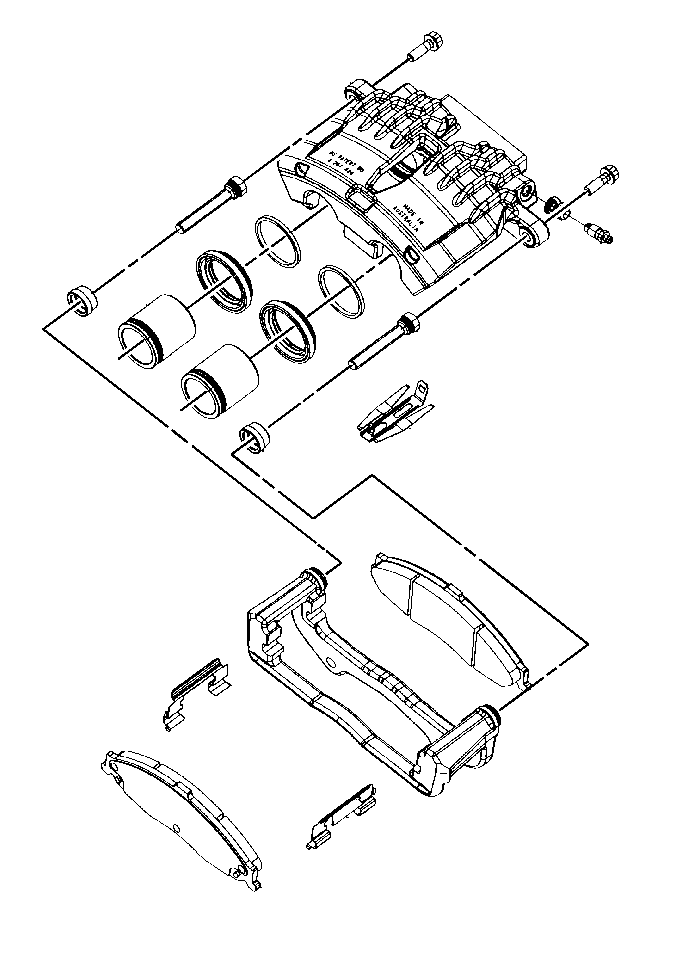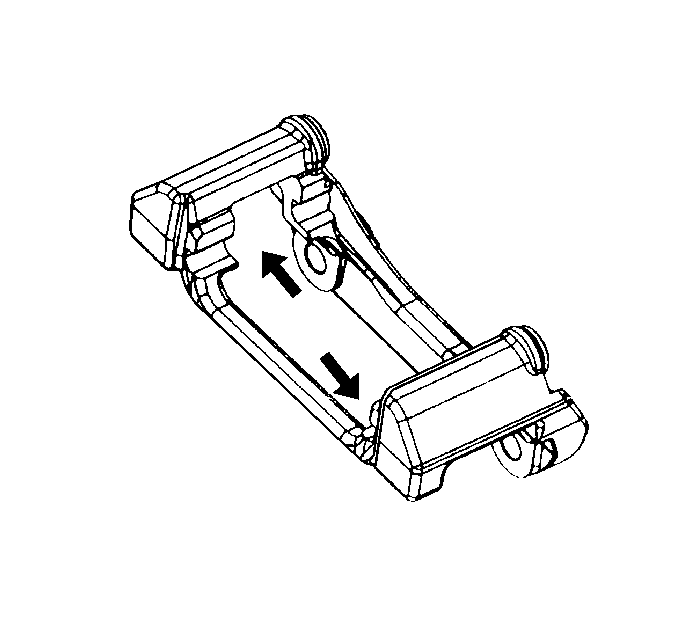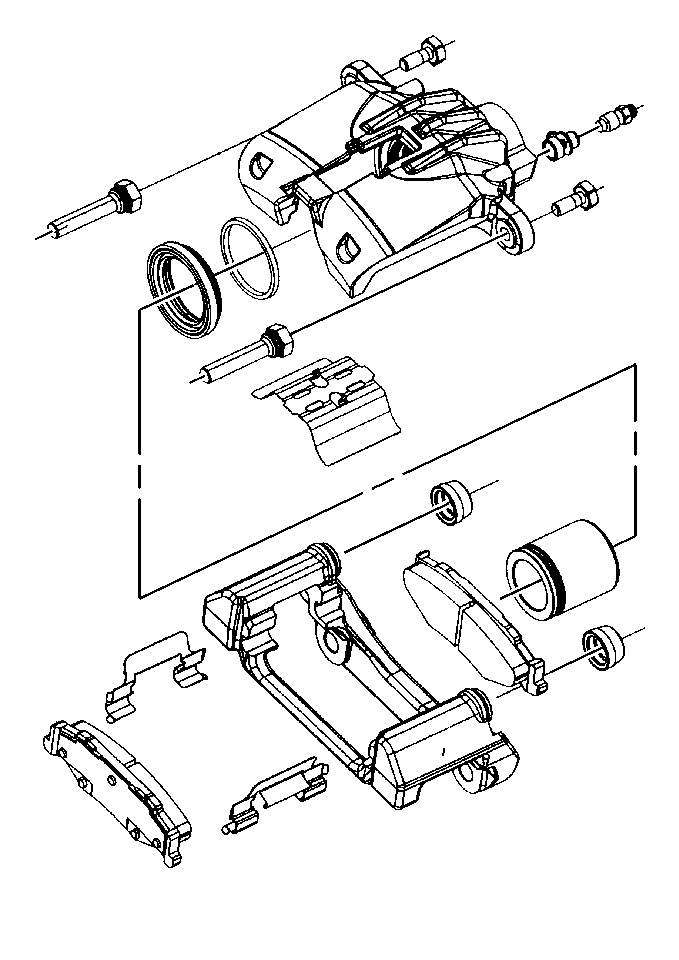Brake Caliper Overhaul Front
Disassembly Procedure

Important:
| • | Replace all the components included in the repair kits used to
service this brake caliper. |
| • | Lubricate the rubber parts with clean brake fluid to make assembly
easier. |
| • | If any hydraulic component is removed or disconnected, it may
be necessary to bleed all or part of the brake system. |
| • | Replace the brake pads in axle sets only. |
| • | The torque values specified are for dry, unlubricated fasteners. |
| • | Perform the service operations on a clean bench, free from all
mineral oil materials. |
Caution: Do not place your fingers in front of the piston in order
to catch or protect the piston while applying compressed air. This could result
in serious injury.
- Remove the brake caliper from the vehicle. Refer to
Brake Caliper Replacement
.

- Remove the pistons by
directing compressed air into the brake hose inlet fitting port of the brake
caliper housing.

- Remove the piston boots (2).
- Remove the piston seals (1).

- Remove the brake caliper
bleed screw cap.
- Remove the brake caliper bleed screw (1).
- Inspect the brake caliper bores and piston seal grooves for scoring
and corrosion. If badly scored or corroded around the piston seal area, replace
the brake caliper housing.

- Inspect the brake caliper
mounting bracket guide surfaces for corrosion and wear. Remove and replace
the brake caliper mounting bracket if necessary.
- Clean all the residue from the brake pad guiding surfaces on the
brake caliper housing and the brake caliper mounting bracket.
- Clean all the parts not included in the repair kit with denatured
alcohol.
- Dry all the parts with filtered unlubricated compressed air.
- Blow out all passages in the brake caliper housing and the brake
caliper bleeder valve.
Assembly Procedure

Notice: Use the correct fastener in the correct location. Replacement fasteners
must be the correct part number for that application. Fasteners requiring
replacement or fasteners requiring the use of thread locking compound or sealant
are identified in the service procedure. Do not use paints, lubricants, or
corrosion inhibitors on fasteners or fastener joint surfaces unless specified.
These coatings affect fastener torque and joint clamping force and may damage
the fastener. Use the correct tightening sequence and specifications when
installing fasteners in order to avoid damage to parts and systems.
- Install the brake
caliper bleed screw (1).
Tighten
Tighten the brake caliper bleed screw to 12 N·m (106 lb in).
- Install the brake caliper bleed screw cap.

- Lubricate the new piston
seals and the brake caliper bore seal grooves with brake fluid.
- Install new seals (1) into the brake caliper bore seal
grooves.
- Make sure the seals are not twisted.
- Lubricate the brake caliper bores and the pistons with brake fluid.
- Install the boot (2) and piston (3).
| 7.1. | Install the boot over the end of the piston so that the fold will
face toward the brake caliper housing piston bore opening. |
| 7.2. | Seat the boot into the brake caliper bore groove and slide the
piston into the brake caliper bore. |
| 7.3. | Push down the piston to the bottom of the brake caliper bore. |
| 7.4. | Make sure the boot is properly seated into the piston groove and
into the groove in the brake caliper bore. |
| 7.5. | Repeat Steps 5 and 6 for the remaining piston. |
- Install the brake caliper to the vehicle. Refer to
Brake Caliper Replacement
.
Brake Caliper Overhaul Rear
Disassembly Procedure

Important:
| • | Replace all the components included in the repair kits used to
service this brake caliper. |
| • | Lubricate the rubber parts with clean brake fluid to make assembly
easier. |
| • | If any hydraulic component is removed or disconnected, it may
be necessary to bleed all or part of the brake system. |
| • | Replace the brake pads in axle sets only. |
| • | The torque values specified are for dry, unlubricated fasteners. |
| • | Perform the service operations on a clean bench, free from all
mineral oil materials. |
Caution: Do not place your fingers in front of the piston in order
to catch or protect the piston while applying compressed air. This could result
in serious injury.
- Remove the brake caliper from the vehicle. Refer to
Brake Caliper Replacement
.

- Remove the piston by directing
compressed air into the brake hose inlet fitting port of the brake caliper
housing.

- Remove the piston boot (2).
- Remove the piston seal (1).

- Remove the brake caliper
bleed screw cap.
- Remove the brake caliper bleed screw (1).
- Inspect the brake caliper bore and piston seal groove for scoring
and corrosion. If badly scored or corroded around the piston seal area, replace
the brake caliper housing.

- Inspect the brake caliper
mounting bracket guide surfaces for corrosion and wear. Remove and replace
the brake caliper mounting bracket if necessary.
- Clean all the residue from the brake pad guiding surfaces on the
brake caliper housing and the brake caliper mounting bracket.
- Clean all the parts not included in the repair kit with denatured
alcohol.
- Dry all the parts with filtered unlubricated compressed air.
- Blow out all passages in the brake caliper housing and the brake
caliper bleeder valve.
Assembly Procedure

Notice: Use the correct fastener in the correct location. Replacement fasteners
must be the correct part number for that application. Fasteners requiring
replacement or fasteners requiring the use of thread locking compound or sealant
are identified in the service procedure. Do not use paints, lubricants, or
corrosion inhibitors on fasteners or fastener joint surfaces unless specified.
These coatings affect fastener torque and joint clamping force and may damage
the fastener. Use the correct tightening sequence and specifications when
installing fasteners in order to avoid damage to parts and systems.
- Install the brake
caliper bleed screw (1).
Tighten
Tighten the brake caliper bleed screw to 12 N·m (106 lb in).
- Install the brake caliper bleed screw cap.

- Lubricate the new piston
seal and the brake caliper bore seal groove with brake fluid.
- Install the new seal (1) into the brake caliper bore seal
groove.
- Make sure the seal is not twisted.
- Lubricate the brake caliper bore and the piston with brake fluid.
- Install the boot (2) and piston.
| 7.1. | Install the boot over the end of the piston so that the fold will
face toward the brake caliper housing piston bore opening. |
| 7.2. | Seat the boot into the brake caliper bore groove and slide the
piston into the brake caliper bore. |
| 7.3. | Push down the piston to the bottom of the brake caliper bore. |
| 7.4. | Make sure the boot is properly seated into the piston groove and
into the groove in the brake caliper bore. |
| 7.5. | Repeat Steps 5 and 6 for the remaining piston. |
- Install the brake caliper to the vehicle. Refer to
Brake Caliper Replacement
.














